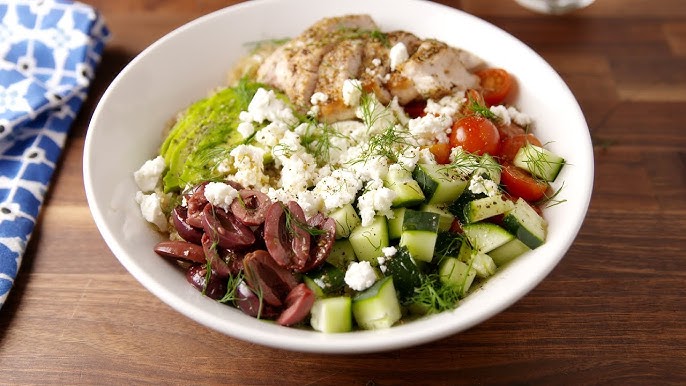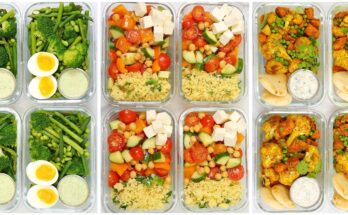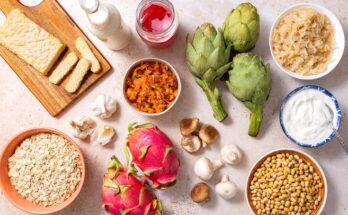Greek Bowl Recipe: A Greek bowl is a wholesome, vibrant, and incredibly satisfying meal that combines all the delicious elements of Greek cuisine into one bowl. Think juicy grilled meats, crisp and fresh vegetables, tangy olives, creamy feta cheese, hearty grains, and a drizzle of luscious tzatziki sauce—all piled high into one satisfying dish. It’s basically like having a Greek salad, gyro, and rice plate all rolled into one convenient, colorful creation.
Greek bowls are a perfect example of a Mediterranean-inspired power bowl. They strike a balance between bold flavors and nutritional goodness, making them an ideal choice for lunch, dinner, or even meal prep. Whether you’re craving something refreshing yet filling or want to put a healthy spin on your usual meals, this Greek bowl will become a regular favorite.
They’re not only easy to customize but also incredibly forgiving. Want more veggies? Go for it. Prefer chicken over lamb? No problem. Craving something low-carb? Just swap out the grains. The versatility of the Greek bowl is what makes it so appealing.
Why You’ll Love This Recipe
Let’s be real—Greek food is a flavor bomb. And this Greek bowl recipe brings all the hits without the fuss. Here’s why you’re going to fall in love with it:
- Quick and Easy: Perfect for weeknights. You can have everything ready in under 45 minutes.
- Meal-Prep Friendly: Prepare the components ahead of time, store them separately, and assemble when you’re ready to eat.
- Healthy and Balanced: Packed with lean proteins, complex carbs, and loads of fiber-rich veggies.
- Customizable: Whether you’re vegetarian, gluten-free, or dairy-free, there’s room to tweak it your way.
- Incredibly Delicious: From the garlicky tzatziki to the lemony grilled meat—each bite explodes with Mediterranean flavor.
If you’re a fan of layered meals where each spoonful delivers something new—crunch, creaminess, tang, and tenderness—you’re in for a treat.
List of Ingredients You’ll Need
To build the ultimate Greek bowl, you’ll need a mix of fresh produce, a hearty grain base, bold toppings, and a delicious protein. Here’s a complete grocery checklist broken down into categories.
Proteins
This is your main source of satisfaction and satiety. Choose one of the following:
- Grilled Chicken Breast – Marinated in olive oil, lemon juice, garlic, and oregano.
- Lamb or Beef Kofta – Seasoned with cumin, coriander, and paprika.
- Grilled Shrimp – A lighter option, best with garlic-lemon marinade.
- Falafel – For a plant-based option.
- Grilled Tofu – Marinated in Mediterranean spices for a vegan-friendly version.
Vegetables
Fresh, crunchy veggies add texture and color:
- Cherry Tomatoes – Halved for burst-in-your-mouth sweetness.
- Cucumber – Diced or sliced, adds coolness and crunch.
- Red Onion – Thinly sliced, raw or pickled.
- Bell Peppers – Roasted or fresh, any color works.
- Kalamata Olives – A salty, briny pop of flavor.
- Romaine Lettuce or Mixed Greens – As a base or topping.
Grains & Base
The foundation of your bowl. Choose your favorite:
- Brown Rice
- White Rice
- Quinoa
- Couscous
- Cauliflower Rice – For a low-carb version.
Toppings & Dressings
Elevate your bowl with these must-have additions:
- Feta Cheese – Crumbled, adds creaminess and saltiness.
- Tzatziki Sauce – Greek yogurt, cucumber, garlic, lemon juice.
- Hummus – Optional, but delicious and filling.
- Lemon Wedges – To brighten everything up.
- Fresh Parsley or Dill – For garnish.
Optional Add-ons
If you want to go gourmet or bulk up your bowl:
- Roasted Chickpeas
- Artichoke Hearts
- Sun-Dried Tomatoes
- Pita Chips or Pita Bread on the Side
Step-by-Step Guide to Making a Greek Bowl
Now that you’ve gathered all your ingredients, it’s time to make the magic happen. Each step is super simple, but together, they build a bowl full of incredible flavor and texture.
Step 1: Choose and Cook the Grain
The base of your bowl sets the tone for everything else. While you can go traditional with white rice or couscous, brown rice or quinoa will give you more fiber and nutrients. Here’s a quick guide:
How to Cook Quinoa (for 2 bowls):
- Rinse 1 cup of quinoa under cold water to remove bitterness.
- Combine with 2 cups water in a pot. Bring to a boil.
- Reduce heat, cover, and simmer for 15 minutes until fluffy.
- Let it sit for 5 minutes, then fluff with a fork.
Cooking Tips:
- Add a pinch of salt and a splash of olive oil or lemon juice for flavor.
- For extra Mediterranean flair, cook your grains in vegetable broth instead of water.
Whether you use rice, quinoa, or couscous, make sure it’s fluffy and not overly moist—you don’t want it soaking into the other ingredients and turning your bowl soggy.
Step 2: Marinate and Cook the Protein
This step is where your Greek bowl gets its savory, meaty punch. Whether you’re using chicken, lamb, tofu, or falafel, proper seasoning and marinating can take it to the next level.
Greek Chicken Marinade:
For two chicken breasts (serves 2 bowls), mix:
- 2 tablespoons olive oil
- Juice of 1 lemon
- 2 garlic cloves, minced
- 1 teaspoon dried oregano
- ½ teaspoon salt
- ¼ teaspoon black pepper
Instructions:
- Place your protein in a zip-lock bag or shallow dish.
- Pour the marinade over it and refrigerate for 30 minutes to 2 hours (longer = more flavor).
- Grill, pan-fry, or bake until fully cooked and golden brown on the outside.
Cook Times (Approximate):
- Chicken Breast: Grill or pan-fry 6–7 minutes per side
- Shrimp: 2–3 minutes per side
- Lamb: Grill 3–4 minutes per side for medium
- Tofu: Pan-sear or grill 5–6 minutes each side
Pro Tip: If you’re in a rush, skip the marinating and just rub the protein with olive oil, lemon, garlic, and herbs before cooking. You’ll still get great flavor with minimal effort.
Step 3: Chop and Prep the Veggies
This is your chance to bring freshness and crunch to the bowl. What makes Greek cuisine so refreshing is the balance of raw, crisp veggies with grilled, warm ingredients.
Must-Have Veggies for 2 Bowls:
- ½ cucumber, diced or sliced
- 1 cup cherry tomatoes, halved
- ½ red onion, thinly sliced
- ½ cup Kalamata olives, pitted and halved
- ½ bell pepper, sliced
- 1–2 cups mixed greens or chopped romaine
Optional Add-Ons:
- Pickled onions (adds tang)
- Roasted red peppers
- Artichoke hearts
- Sun-dried tomatoes
How to Prep:
- Wash all your veggies thoroughly.
- Chop them to bite-sized pieces so they blend nicely in each spoonful.
- For a visual pop, mix colors—red tomatoes, green cucumbers, purple onions, and bright bell peppers.
If using lettuce or greens, layer them at the bottom or on the side to create a balanced mix between warm and cold components.
Step 4: Make the Tzatziki Sauce or Dressing
This is the creamy, garlicky, herby crown jewel of your Greek bowl. Tzatziki not only adds richness but also cools down the spices from the meat and balances out the acidity from the veggies.
Ingredients for Homemade Tzatziki:
- 1 cup Greek yogurt (full-fat preferred)
- ½ cucumber, grated and drained
- 1 garlic clove, minced
- 1 tablespoon lemon juice
- 1 tablespoon olive oil
- 1 tablespoon chopped dill (or mint)
- Salt to taste
Instructions:
- Peel and grate the cucumber, then squeeze out excess water using a paper towel.
- Mix all ingredients in a bowl until well combined.
- Chill for at least 10–15 minutes before serving.
Alternative Dressings:
- Lemon-tahini sauce
- Greek vinaigrette (olive oil, red wine vinegar, oregano, mustard)
- Store-bought tzatziki (check for real yogurt and no added sugar)
Pro Tip: Make a big batch and store in the fridge for up to 4 days—it’s great as a dip, sandwich spread, or salad dressing too!
Step 5: Assemble the Bowl
Now the fun part—building your beautiful, drool-worthy Greek bowl.
Assembly Instructions (per bowl):
- Start with your grain base: Add about ½ to 1 cup of cooked rice, quinoa, or couscous.
- Add greens (optional): A small handful of lettuce or arugula adds a fresh crunch.
- Layer your protein: Slice grilled chicken, lamb, or tofu and lay it over the grains.
- Add your veggies: Distribute cucumber, tomatoes, onions, olives, and bell peppers across the bowl.
- Top with tzatziki: Add a generous dollop in the center or drizzle it all over.
- Finish with garnishes: Crumbled feta, a squeeze of lemon juice, a drizzle of olive oil, and fresh herbs like parsley or dill.
Optional Extras:
- Spoonful of hummus on the side
- Sprinkle of za’atar or sumac for extra depth
- Toasted pita or pita chips for crunch
The final product should be colorful, balanced, and full of layers. Each bite should offer a little crunch, a little creaminess, a bit of tang, and a whole lot of flavor.
Pro Tips for the Perfect Greek Bowl
Balancing Flavors and Textures
One of the biggest secrets to making an unforgettable Greek bowl is achieving the right balance between flavors and textures. Greek cuisine thrives on contrasts—crisp and soft, salty and fresh, tangy and creamy.
Here’s how to strike that perfect balance:
- Include something juicy: Cherry tomatoes or cucumbers bring in moisture and brightness.
- Add something creamy: Tzatziki or feta rounds out the tang and adds luxury.
- Have a salty bite: Kalamata olives and feta are briny, salty, and addicting.
- Crunchy elements: Fresh red onion or toasted chickpeas give each bite an audible snap.
- Warm meets cool: Warm proteins or grains paired with cool sauce and fresh veggies create the ideal contrast.
Flavor Layering Tips:
- Marinate your proteins for at least 30 minutes to let the herbs penetrate.
- Add fresh herbs like dill or parsley last so their aroma stays bright.
- A squeeze of lemon just before serving adds the perfect finishing touch.
Texture matters just as much as flavor in making your bowl feel satisfying and complete.
Make-Ahead and Meal Prep Tips
Greek bowls are a meal-prepper’s dream. Each component can be made ahead and stored separately, giving you a quick and healthy lunch or dinner option all week long.
Meal Prep Tips:
- Cook your grains in bulk: Make enough quinoa or rice for the week and portion it out into containers.
- Grill proteins ahead of time: Chicken, lamb, or tofu can be cooked and stored in airtight containers for 3–4 days.
- Prep your veggies: Chop tomatoes, cucumbers, onions, and peppers in advance. Store each separately to keep them fresh.
- Make a batch of tzatziki: It lasts up to 4–5 days in the fridge and gets even better as the flavors meld.
Storage Recommendations:
- Keep wet ingredients like tzatziki separate until serving.
- Store cooked proteins and grains in one container, and veggies in another.
- Assemble fresh each day for best texture and flavor—or layer in a jar for a “grab-and-go” lunch.
When you prep your ingredients smartly, making a Greek bowl is as easy as layering leftovers—only they don’t taste like leftovers.
Variations and Customizations
Greek bowls are incredibly adaptable, and that’s a huge part of their appeal. No matter your dietary needs or preferences, there’s a way to make this bowl work for you.
Vegetarian and Vegan Options
Don’t eat meat or animal products? No worries. Greek flavors shine just as brightly in plant-based form.
Vegan Proteins:
- Falafel: Packed with chickpeas, herbs, and spices.
- Grilled or baked tofu: Soaks up Mediterranean marinades like a champ.
- Tempeh: Another protein-rich option with great texture.
- Chickpeas or lentils: Roasted for crunch or served warm with spices.
Dairy-Free Substitutes:
- Use a dairy-free yogurt (like almond or coconut-based) for the tzatziki.
- Swap feta with vegan feta or leave it out entirely.
Add more veggies to bulk it up:
- Roasted zucchini or eggplant
- Grilled portobello mushrooms
- Shaved Brussels sprouts or kale
You’ll still get that same bright, bold flavor—just in a completely plant-based way.
Low-Carb and Keto Versions
Watching your carbs? It’s surprisingly easy to turn a Greek bowl into a low-carb masterpiece.
Low-Carb Swaps:
- Replace rice or quinoa with cauliflower rice or shredded cabbage.
- Skip the pita or hummus.
- Choose full-fat Greek yogurt for tzatziki.
High-Protein Additions:
- Add extra grilled chicken or shrimp.
- Toss in hard-boiled eggs or even sliced avocado.
With all the flavor packed in the toppings, you won’t even miss the grains.
Gluten-Free Swaps
This recipe is mostly gluten-free by nature—but a few ingredients require close inspection.
Gluten-Free Tips:
- Double-check couscous—it’s not gluten-free. Use quinoa or rice instead.
- Watch store-bought tzatziki and falafel for hidden gluten.
- Use certified gluten-free pita or crackers if you’re adding them.
With just a few swaps, you’ve got a completely safe, satisfying gluten-free meal loaded with Mediterranean goodness.
Nutrition Information
Calories and Macros Breakdown
Greek bowls are incredibly nutrient-dense and can easily be adjusted based on your dietary goals. Here’s a general idea for a bowl with chicken, quinoa, and tzatziki:
| Component | Calories | Protein | Carbs | Fat |
|---|---|---|---|---|
| Chicken (4 oz) | 180 | 35g | 0g | 4g |
| Quinoa (1 cup) | 220 | 8g | 39g | 4g |
| Tzatziki (2 tbsp) | 60 | 2g | 2g | 4g |
| Veggies & Olives | 70 | 2g | 10g | 5g |
| Feta Cheese (1 oz) | 80 | 4g | 1g | 6g |
Estimated Total: ~610 calories, 51g protein, 52g carbs, 23g fat
Health Benefits of Key Ingredients
- Greek Yogurt: High in protein and probiotics—great for gut health.
- Cucumbers and Tomatoes: Rich in antioxidants and hydration.
- Olive Oil: A heart-healthy fat, staple of the Mediterranean diet.
- Lemon and Garlic: Natural detoxifiers with immune-boosting properties.
- Quinoa: A complete plant protein and great source of fiber.
This bowl isn’t just tasty—it’s a nutritional powerhouse that supports energy, digestion, and long-term wellness.
Serving Suggestions
Best Sides and Drinks to Pair With
Although Greek bowls are filling on their own, adding a few complementary sides or drinks can elevate the entire meal experience.
Side Dishes to Serve With Greek Bowls:
- Pita Bread or Pita Chips: Warm and soft pita is perfect for scooping up tzatziki or wrapping leftover bites.
- Dolmas (Stuffed Grape Leaves): A tangy, herby appetizer that adds another layer of Mediterranean flavor.
- Greek Lemon Potatoes: Oven-roasted with olive oil, lemon, and oregano—rich and comforting.
- Spanakopita: A spinach and feta pastry that adds a savory crunch to the meal.
- Lentil or Chickpea Soup: A warming and nutritious side, especially in cooler months.
Drink Pairings:
- Iced Mint Lemonade: Bright, citrusy, and refreshing.
- Greek Iced Coffee (Frappe): Lightly sweetened and frothy—great for brunch-style bowls.
- White Wine (like Assyrtiko): Crisp and zesty, perfect with grilled chicken or seafood.
- Sparkling Water with Cucumber Slices: Keeps the meal feeling light and fresh.
These sides and drinks round out your Greek feast and make it suitable for dinner parties, family gatherings, or just a solo gourmet night in.
How to Serve for Meal Prep or Dinner Party
Meal Prep Method:
- Use compartmentalized containers to separate grains, proteins, and veggies.
- Pack tzatziki or dressing in a small side container to prevent sogginess.
- Store in the fridge for up to 4 days. Microwave the grains and protein, then add cold toppings.
For Dinner Parties:
- Create a DIY Greek Bowl Bar—set out all ingredients buffet-style and let guests build their own.
- Provide a variety of toppings, sauces, and proteins to cater to dietary needs.
- Offer side dishes like hummus, pita, olives, and dolmas to complete the spread.
- Add candles, fresh herbs, and Greek music for a Mediterranean vibe.
Hosting with Greek bowls is a breeze—they look impressive, taste amazing, and give everyone the chance to customize their plate.
Storing and Reheating Tips
Refrigeration
- Grains and Proteins: Store in airtight containers. Lasts up to 4 days in the fridge.
- Veggies: Keep raw veggies like cucumbers and tomatoes in separate containers with paper towels to absorb moisture.
- Tzatziki: Best kept in a glass jar or container; remains fresh for 4–5 days.
Always let hot items cool down before refrigerating to prevent moisture buildup, which leads to sogginess.
Freezing and Thawing
- Proteins: Grilled chicken or lamb can be frozen for up to 2 months. Thaw in the fridge overnight.
- Grains: Cooked rice or quinoa freezes well. Reheat with a splash of water.
- Tzatziki and Raw Veggies: Not recommended for freezing as the texture changes drastically.
If you want a freezer meal version, freeze only the base components (grains + protein), then add fresh toppings after reheating.
Reheating Without Drying Out
- Microwave: Add a splash of water or olive oil to your grains/protein. Cover with a damp paper towel and heat in 30-second bursts.
- Stovetop: Warm grains and proteins in a skillet over medium-low heat with a tiny bit of olive oil or broth.
- Oven: Wrap protein in foil and bake at 300°F for 10–12 minutes.
Avoid microwaving veggies and tzatziki. Add those fresh after heating for the best taste and texture.
Common Mistakes to Avoid
Overcooking Proteins
Overcooked meat becomes dry, chewy, and loses its flavor. Use a meat thermometer to ensure chicken reaches 165°F, and lamb or beef reaches your desired level of doneness.
Pro Tip: Let your protein rest for 5 minutes after cooking. It redistributes the juices and keeps it tender.
Skipping the Marinade
Skipping the marinade is like making a cake without frosting—technically fine, but far less enjoyable.
A 30-minute marinade dramatically improves flavor and tenderness. Even a quick olive oil + lemon + oregano rub can make all the difference.
Using Store-Bought Sauces Without Checking Ingredients
Many store-bought tzatziki or dressings are full of preservatives, sugar, or unnecessary thickeners.
What to look for:
- Real Greek yogurt as the first ingredient
- Minimal added sugar
- No hydrogenated oils or artificial flavors
When in doubt, homemade is always best—and takes less than 10 minutes!
FAQs about Greek Bowl Recipe
1. Can I make the Greek bowl ahead of time?
Yes! Prepare all components ahead and store them separately. Assemble fresh when you’re ready to eat for the best texture and flavor.
2. What’s the best protein for a Greek bowl?
Grilled chicken is the most popular, but lamb, shrimp, falafel, and tofu all work beautifully depending on your preference.
3. Is there a dairy-free option for tzatziki?
Absolutely. Use a plant-based yogurt like coconut or almond yogurt. Just make sure it’s unsweetened and thick.
4. Can I use quinoa instead of rice?
Yes, quinoa is a great alternative. It’s protein-rich and gluten-free, making it a perfect base for the bowl.
5. How long does a Greek bowl last in the fridge?
Each component can last 3–4 days when stored separately. Assembled bowls are best eaten within 1–2 days to avoid sogginess.
Conclusion
The Greek bowl is more than just a meal—it’s a celebration of vibrant, wholesome ingredients that come together in a simple yet satisfying way. From the perfectly seasoned protein to the creamy tzatziki and the fresh crunch of vegetables, each element plays a vital role in creating a Mediterranean masterpiece that’s as nourishing as it is flavorful.
Whether you’re meal-prepping for the week or hosting a dinner party, this Greek bowl recipe is your golden ticket to stress-free, flavor-packed eating. And the best part? It’s endlessly customizable. Add what you love, skip what you don’t, and make it your own.
So next time you’re craving something healthy, hearty, and delicious, grab your bowl and get stacking—the Greek way.



